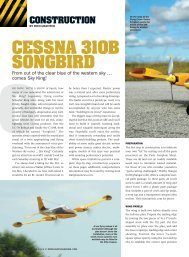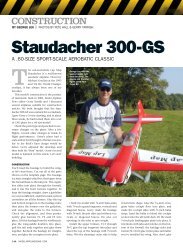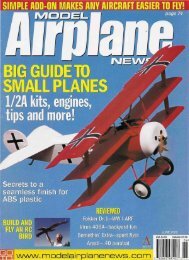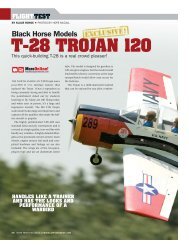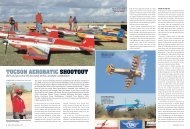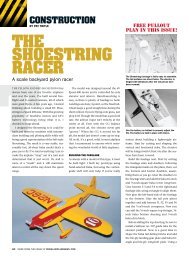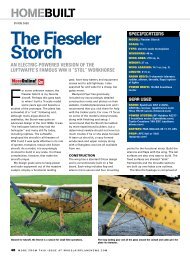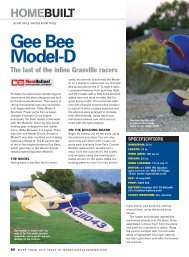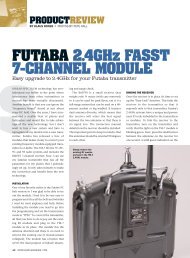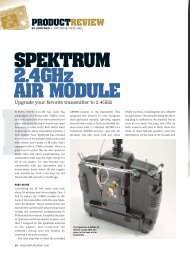JR X9303 2.4
JR X9303 2.4
JR X9303 2.4
You also want an ePaper? Increase the reach of your titles
YUMPU automatically turns print PDFs into web optimized ePapers that Google loves.
RADIOREVIEW <strong>JR</strong> <strong>X9303</strong> <strong>2.4</strong><br />
The main screen on the <strong>X9303</strong> <strong>2.4</strong> is very easy to read. Navigation and adjustment of the radio’s various<br />
menus is made easy with the unique roller selector switch to the right of the screen.<br />
• Flap system (3-position with elevator compensation<br />
and delay)<br />
• Snap-roll system (with 4 directions<br />
and rates)<br />
• Gyro system (3 gains for up to 2 gyros)<br />
• Servo-speed adjustment (in both directions)<br />
• Programmable mixers (6 total; 2 with<br />
multipoint adjustment)<br />
• Direct servo control (DSC)<br />
MAIN DISPLAY<br />
There’s very little confusion while navigating<br />
the transmitter’s many program menus. The<br />
main display shows the current model type<br />
(with a graphic symbol) the trim positions,<br />
the battery voltage, the model number and<br />
the model’s name if you input that information.<br />
The function screen is where you find<br />
menus for dual rates/expo, servo-reversing,<br />
subtrim, servo-travel adjustment, elevator-toflap<br />
and aileron-to-rudder mixing, throttle<br />
curves, flap system, servo speed, snap roll,<br />
servo-speed adjustment and programmable<br />
mixers 1 through 6. You also find the trainer,<br />
timer and servo monitor menus.<br />
In the system menus (press the enter button<br />
and turn on the radio), you find the model<br />
select, model name, type select, model memory<br />
reset, data transfer, trim step function, device<br />
(switch) selection and wing-type menus.<br />
The navigation and adjustment of these program<br />
functions is well detailed in my XP9303<br />
review, and the process is easy and intuitive.<br />
MODELMATCH<br />
This feature puts an end to the “wrong model<br />
94 MODELAIRPLANENEWS.COM<br />
syndrome” if you neglect to double-check that<br />
you have the correct model name on the transmitter<br />
display before you fly your model. A<br />
unique code embedded in the signal, will prevent<br />
the receiver from responding if the wrong<br />
model’s name is on the transmitter’s screen.<br />
SERVOSYNC<br />
This new feature actually re-sequences data<br />
the transmitter transmits based on the type of<br />
mixing you select. So, if you use dual elevators<br />
on a giant model or a 3-servo CCPM setup for<br />
<strong>X9303</strong> <strong>2.4</strong> FEATURES<br />
The <strong>X9303</strong> <strong>2.4</strong> has aircraft, sailplane<br />
and helicopter software menus.<br />
Here are the basic aircraft program<br />
features:<br />
■ Switch assignment<br />
■ Flight modes (3 aircraft, 5 sailplane, 6<br />
helicopter)<br />
■ Dual rates for aileron, rudder and<br />
elevator (3 with flight modes)<br />
■ Adjustable flight trims<br />
■ Fail-safe (with hold and predetermined<br />
servo positioning)<br />
■ Trainer system (selectable channels)<br />
■ Timers (stopwatch, countdown and<br />
integrated)<br />
■ Servo monitor<br />
■ ModelMatch<br />
■ ServoSync<br />
■ Model memory transfer system<br />
■ Model copy system<br />
your helicopter, ServoSync ensures that the<br />
servos that work together will receive their<br />
impulses together. This allows the servo<br />
movements to be more synchronized for<br />
improved response.<br />
RECEIVER<br />
The <strong>JR</strong> R921 <strong>2.4</strong> is a full-range receiver featuring<br />
DuaLink technology and is actually two<br />
receivers that each has its own set of antennas.<br />
When powered up, the receiver scans the<br />
<strong>2.4</strong>GHz band to find the transmitter it has been<br />
programmed to recognize, and it locks on to its<br />
signal. The second receiver circuit then repeats<br />
the process and locks on to a second signal to<br />
establish a dual-signal link to the transmitter.<br />
The two antennas virtually eliminate<br />
blocked-signal interference from nearby metal<br />
objects such as big glow- and gas-powered<br />
models and large battery packs. As with all<br />
<strong>2.4</strong>GHz radio systems, the transmitter signal<br />
beam is line-of-sight, so always avoid flying<br />
behind large buildings or objects that could<br />
block the signal.<br />
Binding. Binding programs the receiver to recognize<br />
your transmitter, and it’s done at the<br />
factory. Binding or rebinding is necessary if<br />
you purchase another receiver to use with<br />
your transmitter and if you want to change<br />
the built-in throttle-smart fail-safe settings.<br />
Smart fail-safe. This built-in feature is set so that<br />
if there is a signal loss, the throttle will go to a<br />
low setting, and the other control channels will<br />
remain in their last positions. If you turn on the<br />
receiver before the transmitter, all the channels<br />
go to their fail-safe positions (set during the<br />
binding process), but as a safety feature, the<br />
throttle channel does not produce a signal<br />
pulse, so it can’t activate an electric model’s<br />
ESC. The instruction manual explains the<br />
binding and fail-safe setting processes in detail.<br />
BOTTOM LINE<br />
The <strong>JR</strong> <strong>X9303</strong> <strong>2.4</strong> is a user-friendly radio system<br />
that’s ideally suited to intermediate to<br />
expert fliers. I especially like the fact that with<br />
its transfer system, you can easily bring all<br />
your XP9303 model memories into the <strong>X9303</strong><br />
<strong>2.4</strong>. This is a real time saver. Add the<br />
frequency freedom of DSM <strong>2.4</strong>GHz frequency<br />
modulation and the ability to link to all older<br />
Spektrum receivers, and you have a radio<br />
system that’s ideal types of RC flying.<br />
See the Source Guide for manufacturers’ contact information.



